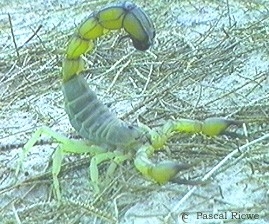Androctonus australis
(Ewing, 1928)
|
|

|
|
Common names:
This scorpion is known as the Fat Tailed
Scorpion, due to its powerful cauda.
Distribution:
Africa (Algeria, Chad, Egypt, libya, Mauritania, Somalia,
Sudan, Tunisia) and Asia (India, Israel, Pakistan, Saudi
Arabia, Yemen).
Habitat:
This scorpion is found in dry habitats/desert areas. It
is found in stony soils, catus hedges, arid mountainous
regions and high plateaux. It can also be found on steep
slopes of drifting sand dunes. It avoid humid costal
areas. The scorpion dosen't dig large burrows, but hide
under stones and in natural crevices. This species is
unfortunately often found near human habitations (in
cracks in walls etc. made of stones and bricks).
Venom:
This is one of the worldst most dangerous
scorpion, with a very potent venom. This species are
medical important, and cause several deaths each year.
Two different sources list LD 50 values of 0.32 and 0.75
mg/kg.
See Scorpion of Medical
Importance page for more information.
Selected litterature:
Goyffon, M., M. Vachon, et al. (1982).
Epidemiological and clinical characteristics of the
scorpion evenomation in Tunisia. Toxicon 20(1), pp.
337-344.
Schmidbauer, H. (1982). Erfahrungen bei der nachsuch von
Sahara-Dickschwanzskorpion. Herpetofauna, Juni, pp.16-21.
Bonnet, M.S. (1997). Toxicology of Androctonus
scorpion. Br. Homoeopathic Journal, 86, pp. 142-151.
Gaban, D. (1997). On: Androctonus australis (L.)
Fattailed scorpion. Forum American Tarantula Society
6(2), pp. 52-53.
Schiejok, H. (1996). Androctonus australis
(Linnaeus, 1758). Eine monographie. Skorpion News,
Remscheid: Buthus-Fachverlag. 38 pp.
Abroug, F. et al. (1991). Cardiac dysfunctioning and
pulmonary edema following scorpion envenomation. Chest,
100(4), pp. 1057-1059.
On the Internet:
Pascal
Riews work on A. australis.
Gifttier
Informationsdienst on A. australis.
General:
This scorpion is a medium sized scorpion which can get up
to 10 cm in lenghts. It has a very tick and powerful
cauda. Overall coloration is yellow, with the palpal
pincers sometimes darker (please note that this species
variates in colors). The last segments of the cauda is
sometimes darker than the rest of the cauda.
This species is beeing kept in captivity. Under no
circumstances should this species be kept by other than
scientists or professional keepers. This is a very
dangerous species!
I'm not aware of any research on the biology of this
species, but research on and with Androctonus
venom is going on all the time.
Androctonus australis photo by
Pascal Riewe (C)
|

